On June 5, German Chancellor Friedrich Merz met U.S. President Donald Trump at the White House for the leaders’ first face-to-face meeting. The odds of “Friedrich” and “Donald”—according to reports, they started using first names in a series of phone calls preceding their first meeting—getting along were not bad. Both men are conservatives, former businessmen and multimillionaires, and in their respective campaigns promised to crack down on irregular immigration.
Yet there was no lack of tension points: the second round of direct talks between Ukraine and Russia since early 2022, Trump’s tariffs, and American officials’ blunt interference in the domestic affairs of European allies, particularly Germany.
For Trump, the visit held no special importance—apart from another opportunity for “great television.” For the new German chancellor, in contrast, the stakes of the visit could not have been higher. The international environment is dire; an adversarial encounter with the U.S. president would have been highly unfortunate.
Navigating international disorder
Germany and its European NATO allies face an imminent threat from Vladimir Putin’s Russia, which continues to wage its illegal war of aggression in Ukraine while attempting to destabilize Ukraine’s Western supporters through increased hybrid attacks throughout the continent. It is openly supported in all this by China, which, while an essential trade partner for the European Union (EU) and Germany, is also attempting to gain political leverage over Europe through instrumentalizing dependencies and supply chains.
During his first week in office, Merz visited Paris and Warsaw to meet bilaterally with French President Emmanuel Macron and Polish Prime Minister Donald Tusk, engaged with EU and NATO leaders in Brussels, and traveled by train to Kyiv with his French, British, and Polish counterparts to demonstrate his support for Ukraine, its government, and its people. He has made it clear that he wants Germany to play an active role in shaping Europe’s response to Putin’s aggression and ensure it can defend itself against an imperialist Russia—including by forging an alliance to loosen the constitutional debt brake. After the February election yet prior to his confirmation as chancellor, Merz called an emergency meeting in the old legislature to put together a 500-billion-euro ($545 billion) debt-financed off-budget fund for investments in infrastructure over the next 12 years, in collaboration with other centrist parties. The bill also exempts defense spending over 1% of GDP from the debt brake. But here too, the challenge lies in the execution, and in persuading a skeptical electorate that increased defense spending will not come at the expense of social budgets. An especially fraught debate awaits over the possible reintroduction of conscription.
Yet the most difficult conundrum for Merz—a perennial transatlanticist—is a U.S. administration that treats Europe more like an antagonist than an ally. Trump’s frequent criticisms of NATO and complaints about allied defense spending have forced Europeans to question whether America still views peace and stability in Europe (much less the future of Ukraine as a sovereign country) as a vital national security interest. Europeans have now largely accepted the Trump administration’s demand that member states spend 5% of their GDP on defense (albeit with the caveat of a 3.5%/1.5% split between hard defense costs and infrastructure investments). They also understand that another Ukraine supplemental aid package is highly unlikely, that there will be U.S. troop reductions following the Hague NATO summit on June 24-25, and that allied discussions of Russia and China strategy will be largely shelved. Berlin and other European capitals must now focus their diplomatic efforts on working with the Trump administration to enable an orderly, planned transition to a nearly-complete shifting of the European defense burden to Europe—rather than a chaotic process that would tempt adversaries to exploit their vulnerabilities.
On the day before Merz’s visit, the United States also increased steel and aluminum tariffs to 50%, dealing a significant blow to Europe, which exports billions of dollars’ worth of the metals to the United States every year. Trump’s “reciprocal” tariffs are on hold until July, but a full-blown return to the Trump administration’s efforts to coerce its European allies into accepting a revision of the global trade and currency order could significantly harm the continent’s economy—and undercut its efforts at rearming. While trade negotiations are the exclusive province of the European Commission, Germany, as the EU’s largest economy, has a role to play in identifying and supporting a mutually acceptable “deal.”
U.S. officials’ public support for the far-right Alternative for Germany (AfD) party, however—such as in Vice President JD Vance’s confrontational speech at the Munich Security Conference—is a bright red line for Merz. One in five German voters cast their ballots for the AfD in February’s election, making it the strongest opposition force in the Bundestag. The party was recently formally designated as “right-wing extremist” by Germany’s domestic intelligence agency (the classification was suspended pending the resolution of a lawsuit filed by the party). The AfD’s leaders have made it clear that they aim to be in government after the next election.
A recent Substack article by the U.S. Department of State attacking centrist European governments and namechecking far-right parties including the AfD confirmed the chasm between the current American and most European governments’ interpretations of democracy. What the Trump administration views as “censorship, demonization, and bureaucratic weaponization,” centrist Europeans—and Merz chief among them—understand as a responsibility to protect foundational elements of their constitutional democracies.
The Oval Office encounter and what’s next
Given the stakes, Merz’s meeting with Trump went remarkably well. Presenting the president with a framed birth certificate of his German-born grandfather—whose name, by a happy coincidence, was also Friedrich—set a positive tone. On the substance, and especially on current transatlantic disputes, the delegation from Berlin returned empty-handed. Trump spoke for most of the 42-minute public sit-down. Meanwhile, his German visitor wisely confined himself to stressing his unwavering support for Ukraine and pointing out that it attacks only military targets, while Russia bombards civilian habitations and infrastructure every day. The chancellor also emphasized his and Trump’s shared desire to bring an end to the war, hinting at the unique leverage the United States holds to pressure the Kremlin and—on the day before the 81st anniversary of D-Day—reminding the president of the crucial role of American engagement to once again help bring a war on the European continent to an end. When the president responded that “that was not a pleasant day” for Germany, Merz firmly reminded him that June 6 is seen as a “day of liberation” by all Germany (with the exception of actual neo-Nazis).
No other topics of dispute were addressed in the public part of the meeting, although Merz was at pains later to stress that the closed-door conversations on trade had gone very well. At a time of floating rumors about at least two private U.S.-Russian efforts to bring the controversial Nord Stream 2 pipeline back online, it was also quite useful to have Trump himself put a public stamp of approval on Merz’s stated determination to keep the pipeline closed.
In sum: Merz returned to Berlin without any tangible deliverables on critical issues, but with his dignity intact and the foundation laid for a working relationship with the Trump administration. But, as a German soccer (“Fussball” to us) saying goes: “nach dem Spiel ist vor dem Spiel,” or “after the game is before the game.” It’s never over until it’s over, and it’s never over.
Merz and Trump met again on June 15-17 at the Group of Seven summit in Kananaskis, Canada—albeit briefly, because Trump left early due to escalation in the Middle East. They will encounter each other once more on June 24-25 at the NATO summit in the Dutch city of The Hague. Both dates will be overshadowed by the still-suspended trade war. (Tariffs were set to resume in July, but Treasury Secretary Scott Bessent has stated that the deadline might be pushed back.)
For now, therefore, Merz is two out of three in his attempts to evade collision with a uniquely mercurial American president. He also escaped the fate of the Irish Taoiseach (prime minister) Micheál Martin, who returned to Ireland after a perfectly pleasant customary pre-St. Patrick’s Day visit to the Oval Office—only to find Trump hosting the controversial mixed martial arts fighter Conor McGregor five days later. So far, no AfD leader has been sighted near the White House.
Whether and how the German chancellor can leverage a promising but limited relationship with Trump to work for sustainable “deals” on security and trade in multilateral fora—and avoid toxic contamination by ideologues determined to unleash a transatlantic culture war—remains to be seen.
The Brookings Institution is committed to quality, independence, and impact.
We are supported by a diverse array of funders. In line with our values and policies, each Brookings publication represents the sole views of its author(s).
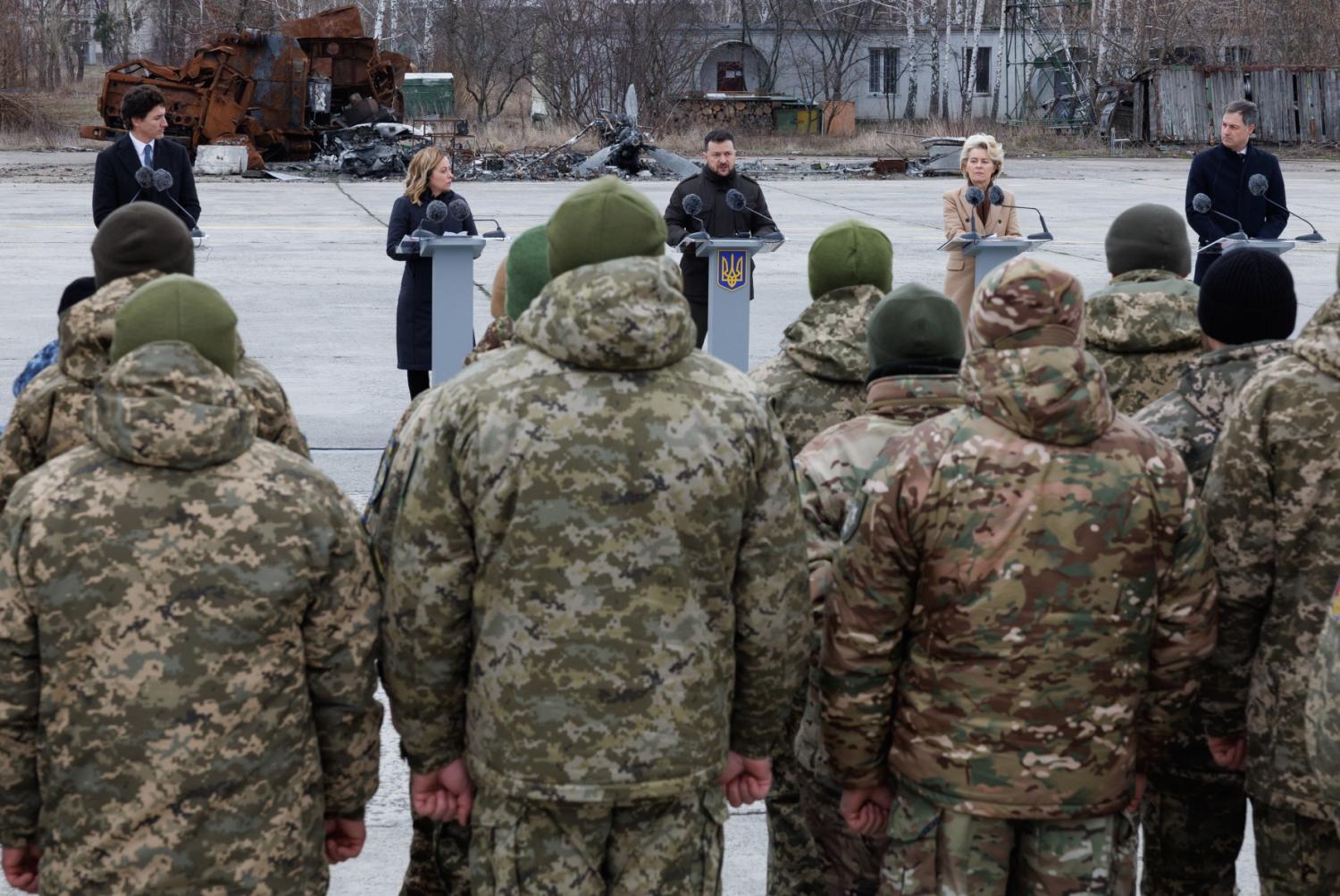
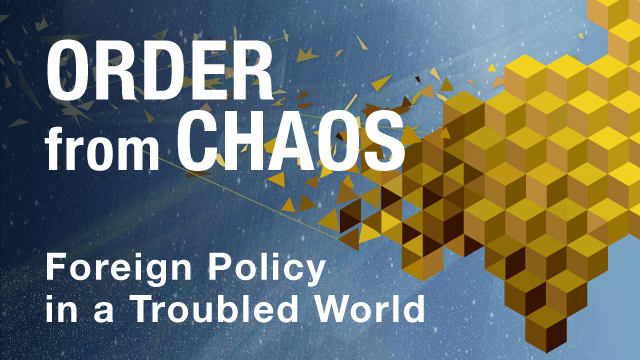

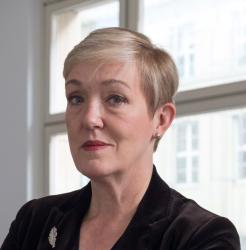
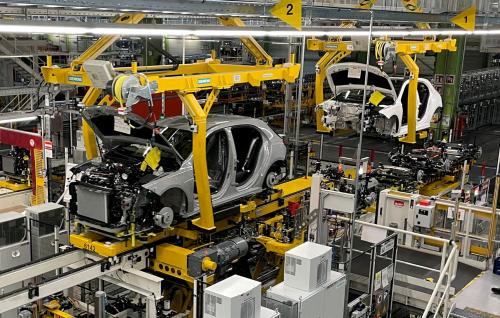
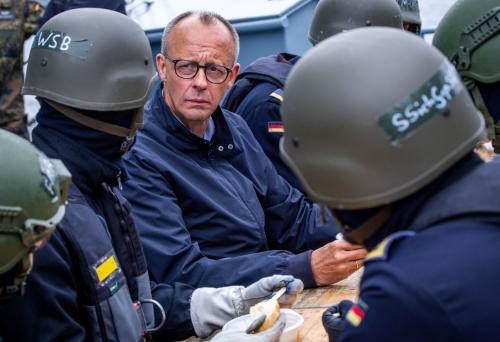
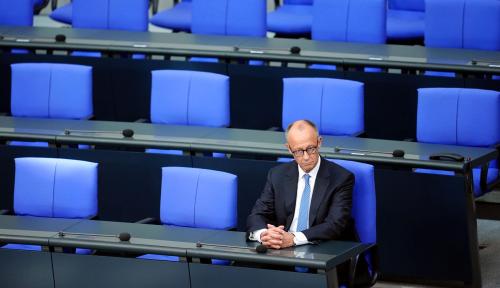
Commentary
Germany’s Chancellor Merz goes to Washington
Whether the German chancellor can leverage a limited relationship with Trump to work for sustainable “deals” on security and trade remains to be seen.
June 17, 2025